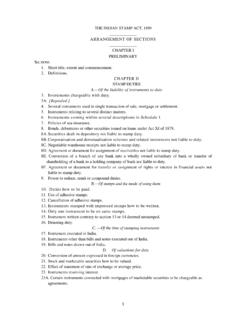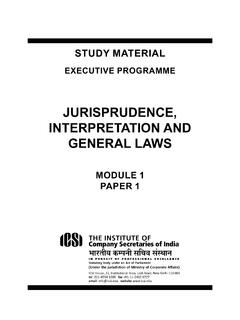Transcription of Indian Stamp Act - S3WaaS
1 Indian Stamp Act Act 2 of 1899 As Applicable to the States of Punjab & Haryana Legislative History 1. Affected by Punjab Act 5 of 1957 2. Amended by Punjab Act 13 of 1958 3. Amended by Punjab Act 26 of 1959 4. Amended by Punjab Act 34 of 1960 5. Amended by Punjab Act 14 of 1961 6. Amended by Punjab Act 11 of 1963 7. Amended by Punjab Act 24 of 1964 8. Amended by Punjab Act 6 of 1965 9. Amended by Haryana Act 2 of 1967 10. Amended by President Act 7 of 1967 11. Amended by Punjab Recorginsation and Delhi High Court Adoption of Laws on Union Subjects) Order 1968 12. Amended by Haryana Act 16 of 1969 13. Amended by Punjab Act 24 of 1971 14. Amended by Haryana Act 49 of 1971 15. Amended by Punjab Act 13 of 1973 16. Amended by Punjab Act 27 of 1973 17. Amended by Haryana Act 37 of 1973 18. Amended by Punjab Act 18 of 1974 19.
2 Amended by Punjab Act 66 of 1976 20. Amended by Punjab Act 28 of 1978 21. Amended by Haryana 17 of 1979 22. Amended by Punjab 21 of 1982 23. Amended by Haryana Act 1 of 1987 24. Amended by Punjab Act 17 of 1994 25. Amended by Punjab Act 18 of 1995 26. Amended by Haryana Act 21 of 1997 27. Amended by Punjab Act 17 of 1998 22. Amended by Haryana Act 10 of 2000 28. Amended by Punjab Act 14 of 2001 An Act to consolidate and amend the law relating to Stamps. Whereas it is expedient to consolidate and amena the law relating to Stamps; it is hereby enacted as follows: CHAPTER I Preliminary 1. Short title, extent and commencement. - (1) This Act may be called the Indian Stamp Act, 1899. 6 Indian Stamp Act, 1 (2) It extends to the whole of India except the State of Jammu and Kashmir: Provided that it shall not apply to 2[the territories which, immediately before the 1st November,1956, were comprised in Part B State ] (excluding the State of Jammu and Kashmir) except to the extent to which the provisions of this Act relate to rates of Stamp duty in respect of the documents specified in entry 91 of list I in the seventh Schedule to the Constitution.
3 (3) It shall come into force on the first day of July, 1899 . NOTES Statement of Objects and Reasons. - Since the Stamp Act of 1879 was passed the Stamp law has been amended by ten different enactments. The present Bill proposes to repeal and reenact in a consolidated form the whole of there enactments. It also proposes to introduce certain amendments where the working of the Stamp law had disclosed defects. Alterations are printed in italics, and the material amendments which it is proposed to introduce are referred to in the notes on clauses given below. For facility of reference a comparative table is appended to this statement, showing how each section of the Indian Stamp Act, 1879, has been dealt with in the present Bill 3. Statement of Object and Reasons - Haryana Act of 1987.
4 - Due to short supply of Non-Judicial Stamp Papers of the value and denomination upto Rs. 10 from the Central Stamp Store, Nasik Road, the public in the State is facing a great difficulty to execute various documents. It is proposed to add a proviso in sub-section (1 )of section 10 of the Indian Stamp Act, 1899 to avoid inconvenience to the public in such a situation. Hence the Indian Stamp (Haryana Amendment) Bill, 1986 .. Object, Scope and. Nature. - The Indian Stamp Act, 1899 has been engrafted in the statute-book to consolidate and amend the law relating to stamps. Its applicability thus stands restricted to the scheme of the Act. It is a true fiscal statute in nature, is such strict construction is requited to be effected and not liberal interpretation. Undoubtedly, Section 2(15) includes a decree of partition and S.
5 35 of the Act of 1899 lays down a bar in the matter of un stamped or insufficient Stamp being admitted in evidence or being acted upon - but that does not mean that the prescribed period shall remain suspended until the Stamp paper is furnished and (lie partition decree is drawn thereon and subsequently signed by tile Judge. Such all interpretation would result in all utter absurdity. The intent of tile legislature in engrafting tile Limitation Act shall have to be given its proper weightage. Absurdity Cannot be tile Outcome of interpretation by a court order and whever there is even a possibility of such absurdity, it would be a plain exercise of judicial power to repel the same. The whole purport of tile Indian Sunni) Act is to make available certain dues and to Collect revenue but it does not mean and imply overriding the effect over another statute operating in a completely different Johran v.
6 Abdul Salam. (2001) 7 sec 573. Applicability -Judicial proceedings - The provisions of the Stamp Act are ordinarily not intended to apply to judicial proceedings. Mis. Label Art Press v. Mis. Indo European Machinery Co. (P) Ltd, 1974 Delhi 136 : 1973 Raj. LR 347. The provisions of Stamp Act are not meant to arm the litigants with the technique to defeat the claim of opponent AIR 1969 sec 1238. Instrument - Determination of - Nature of instrument - For finding out the true'character of an instrument, one had to read the instrument as a whole, and then find out its dominant pur- I. Substituted for the old sub-section by Parliament Act 43 of 1955, section 3. 2. Substituted by Adaptation of Laws ( ), Order, 1956, for the words "Part B States". 3. Gazette oflndia 1897, Part V, page 175.
7 4. Published vide Haryana Government Gazetted (Extra.) dated (Aghn. 4, 1908 Saka) page 1346. 7 pose. A single instrument may embody several purpose. But what is relevant for the purpose of the Stamp Act, is the dominant purpose of the instrument. In the matter of Hamdard Dawakhana (Wakf) De/hi 69 PLRD. 270: 3 413 (FB). Bar against admittance in evidence of un stamped or insufficiently stamped document -The bar is not absolute. Bar stands removed as soon as duty chargeable with prescribed penalty is paid. Person producing unstamped or insufficiently stamped document has a right to claim that instrument be admitted in evidence on payment of deficient Stamp and penalty. Saran Dos v. Smt. Sila, 1986 (1) LLR 275 (HP). Definitions of Registration Act - The Stamp Act and the Registration Act may be read to-gether.
8 The definitions contained in one may be adopted for the purpose of construing the other Act. AIR 1928 Bombay 553; AIR /914 Bombay 55. Interpretation of Registration Act - The object of Stamp Act is only to collect revenue. The object of the Registration Act on the other hand is to prevent people being duped into pur-chasing property from 'a person who does not own it. Principles which govern interpretation of Stamp Act do not govern interpretation of Registration Act. AIR /970 Raj. 171 . Construction of provisions of Stamp Act - The sole object of the Stamp Act is to increase the revenue and therefore all its provisions must be construed as having in view the protection of the revenue. AIR 1927 Mad 786; AIR 1920 Patna 50. Objections relating to Stamp - The Court looks with disfavour upon objections taken merely on account of the absence of stamps as this matter really relates to revenue.
9 AIR 1960 Punjab 182. Stamp Duty is leviable on instrument and not on transaction - The Stamp duty is on the instrument as it stands and not on the transaction. AIR 1935 Lahore 567. 2. Definitions. - In this Act, unless there is something repugnant in the subject or context- (1) "Banker". - "banker" includes a bank and any person acting as a banker; (2) "Bill of exchange" . - "bill of exchange " means a bill of exchange as defined by the Negotiable Instruments Act, 1881, and includes also a hundi, and any other document entitling or purporting to entitle any person whether named therein or not, to payment by any other person of, or to drawn upon any other person for, any sum of money; (3) "Bill of exchange payable on demand". - "bill of exchange payable on demand" includes - (I) an order for the payment of any sum of money by a bill of exchange or promissory note, or for the delivery of any bill of exchange or promissory note in satisfaction of any sum of money, or for the payment of any sum of money out of any particular fund which mayor may not be available, or upon any condition or contingency which mayor may not be performed or happen; (b) an order for the payment of any sum of money weekly, monthly or at any other stated periods; and (c) a letter of credit, that is to say, any instrument by which one person authorises another to give credit to the person in whose favour it is drawn; (4) "Bill of lading".
10 - "bill of lading" includes a "through bill of lading", but does not include a mate's receipt; (5) "Bond" . "bond" includes - 8 Indian Stamp Act, Section 2 (a) any instrument whereby a person obliges himself to pay money to another, on condition that the obligation shall be void if a specified act is performed, or is not performed, as the case may be; (b) any instrument attested by a witness and not 'payable to order or bearer, whereby a person obliges himself to pay money to another; and (c) any instrument so attested, whereby a person obliges himself to deliver grain or other agricultural produce to another; (6) "Chargeable". - "chargeable" mean, as applied to an instrument executed or first executed after the commencement of this Act, chargeable under this Act, and, as app1ied to any other instrument, chargeable under the law in force in India when such instrument was executed or, where several persons executed the instrument at different times, first executed; (7) "Cheque".












